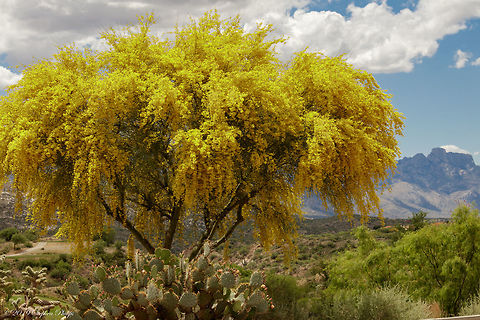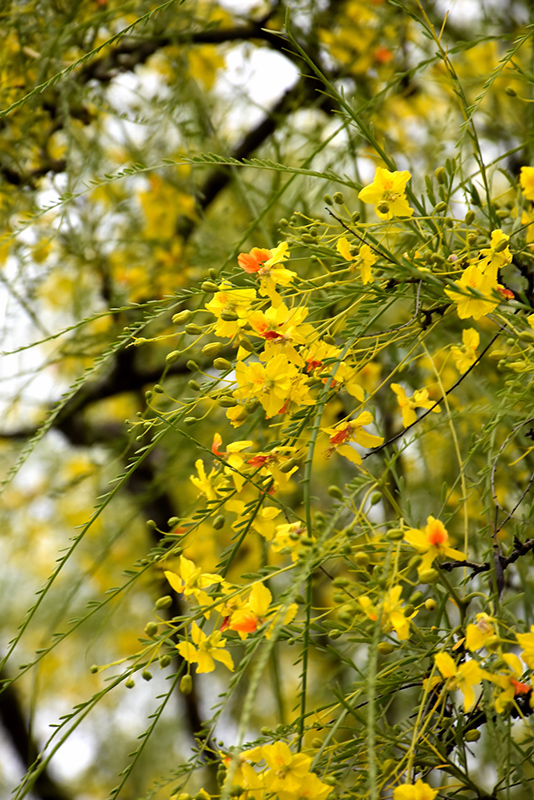Parkinsonia aculeata

Parkinsonia aculeata, commonly known as Mexican Palo Verde or Retama, is a stunning flowering tree native to Mexico and parts of Central and South America.
Admired for its delicate foliage, vibrant yellow flowers, and drought tolerance, this species holds both ecological and cultural significance in arid and semi-arid regions.
In this comprehensive article, we will delve into the botanical intricacies, habitat preferences, life cycle, ecological importance, conservation status, and care guidelines for Parkinsonia aculeata.
Botanical Description
Mexican Palo Verde is characterized by its slender branches, fine-textured foliage, and small thorns.
The tree typically grows to a height of 15 to 25 feet (4.5 to 7.5 meters) with a spread of 10 to 20 feet (3 to 6 meters).
The leaves are compound and feathery, consisting of numerous tiny leaflets that give the tree a delicate appearance. In spring, Mexican Palo Verde produces an abundance of fragrant yellow flowers that cover the canopy in a profusion of color.
The flowers give way to long, slender seed pods that ripen in summer, providing a food source for wildlife.
Habitat and Distribution
Mexican Palo Verde is native to a variety of habitats, including desert scrub, grasslands, and disturbed areas, throughout Mexico and parts of Central and South America.
Life Cycle and Phenology
As a perennial tree species, Parkinsonia aculeata undergoes a yearly life cycle marked by seasonal growth and flowering.
New growth emerges in spring, with the tree producing an abundance of flowers that cover the canopy in a blanket of vibrant yellow.
Flowering typically occurs in response to rainfall or periods of increased moisture, signaling the onset of the growing season.
Mexican Palo Verde may experience a period of reduced growth and dormancy in winter. However, it remains green and photosynthetically active throughout the year.
Ecological and Cultural Importance
Mexican Palo Verde plays a vital ecological role as a habitat provider, supporting a diverse array of wildlife species.
The flowers attract pollinators such as bees, butterflies, and hummingbirds, contributing to the health and diversity of local ecosystems.
The seeds are eaten by birds and small mammals, while the foliage provides shade and refuge for desert wildlife.
Additionally, Mexican Palo Verde has cultural significance as a symbol of resilience, adaptability, and survival in harsh desert environments.
It is often used in landscaping and revegetation projects to restore degraded habitats and stabilize soils.

Caring for Parkinsonia aculeata
Sunlight
Plant Mexican Palo Verde in a location that receives full sun, as it requires abundant sunlight to thrive and bloom profusely.
Watering
Allow the soil to dry out between waterings to prevent root rot.
Soil
Plant in well-drained, sandy or rocky soil with a neutral to slightly acidic pH.
Avoid planting in heavy clay soils, as they can retain too much moisture and lead to root rot.
Mulching
Apply a layer of organic mulch around the base of the tree to conserve moisture and regulate soil temperature.
Keep the mulch several inches away from the trunk to prevent rot.
Pruning
Prune Mexican Palo Verde as needed to remove dead, diseased, or damaged branches.
By adhering to these care instructions, nurture thriving Parkinsonia aculeata trees, enhancing arid landscapes and honoring their resilience in diverse settings.
Leave a Reply
You must be logged in to post a comment.